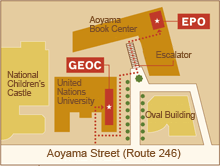Summary
・Cycle of collaboration
 Partnerships require diverse parties to work together, which makes it difficult to completely check everything that occurs throughout the process. There are five steps to follow for a collaboration to steadily address local issues. These steps are certainly not independent of each other. As each complements the other, partnerships are able to develop. Also, depending on the initiative itself and its progress, it might be possible to start from any step and to even skip steps. This collaborative process enables parties to learn from each other as well, and encourages even more partnerships with the community or the society.
Partnerships require diverse parties to work together, which makes it difficult to completely check everything that occurs throughout the process. There are five steps to follow for a collaboration to steadily address local issues. These steps are certainly not independent of each other. As each complements the other, partnerships are able to develop. Also, depending on the initiative itself and its progress, it might be possible to start from any step and to even skip steps. This collaborative process enables parties to learn from each other as well, and encourages even more partnerships with the community or the society.
Trust building
When using synergies within a partnership to confront major issues, trust is able to be built up over time. Participating in unusual events can quickly reduce distances between parties, but daily interactions are also important. Mutual respect of promises and schedules is essential, but the acts of sharing information, interchanging what we need each other, which are not directly related to the project at hand, will strengthen relationships.
Ownership of the process
Independent participation has the effect of boosting self-motivation. When relationships with the businesses and missions of each party in a partnership become visible, the partnership can move forward to the next step. Although simple relationships limited to information exchange are also necessary at the start of a partnership, you need to nurture each other’s independence through active sharing of responsibilities to actually progress an initiative.
Face-to-face dialogue
Honest communication between parties is an essential condition for collaboration. While having a stake in the outcome of a project is great for getting things done, it can make you avoid conflict and remain neutral in your contacts with others, and connections may not function when needed. Communication by email and telephone is both useful and necessary, but it is important to make time for occasional face-to-face dialogue.
Small wins
Achieving small wins provides the energy for participants to move to the next step. Going immediately for a long-term objective makes reduce motivation because participants are unable to see progress. Holding frequent briefings is one way to see where you have come up to. Because partnerships involve a wide range of participants, full discussion starting from how you measure outcomes may also be required. This is why we must also consider evaluation methods that enable greater participation from many people.
Shared understanding
Central to partnerships is the sharing of local issues and future visions to achieve a common understanding among parties. Even things that seemingly need no explanation may be interpreted differently depending on where you stand, so confirmation of matters helps clarify differences. It may take courage to stop and check matters that were not shared sufficiently at first, but always start by documenting even the simplest things.
Information
Publisher: Global Environment Outreach Centre
Language: Japanese
Publication Date: 2018/02

















